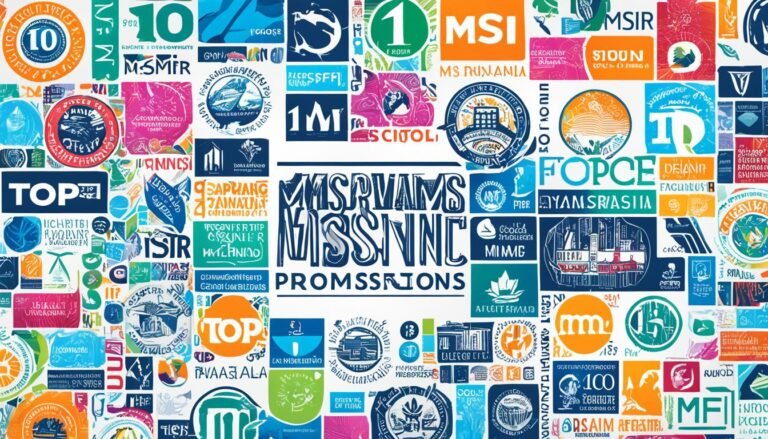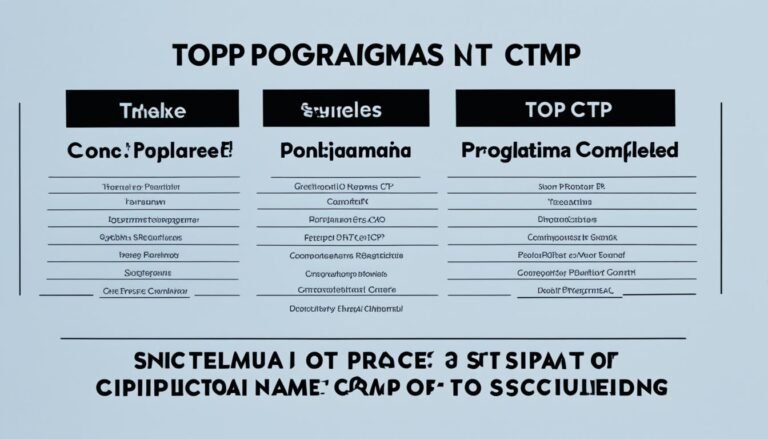Best Master of Risk Management (MRM) Programs
By 2024, the global risk management market could hit $25.66 billion. Businesses face more uncertainties these days. So, they need experts in risk management to protect their investments. There’s a growing need for MRM graduates, making it a great time to consider this degree.
If you’re looking to join finance, consulting, or the insurance world, a good MRM education is key. The top MRM programs, from leading universities and institutions, offer the skills you need. They cover risk assessment, how to reduce risk, and making smart decisions.
Key Takeaways:
- Global risk management market is expected to reach $25.66 billion by 2024.
- Pursuing a Master of Risk Management (MRM) degree provides opportunities in various industries.
- Top universities offer accredited MRM programs that equip students with essential skills.
- MRM programs focus on risk assessment, mitigation, and strategic decision-making.
- A career in risk management offers growth potential and high-demand job prospects.
Program Overview
The Master of Risk Management (MRM) programs teach risk management inside out. They cover the basic principles and best practices. This makes sure students are ready for jobs in risk management.
The course mix includes main classes, specialty topics, and some choice courses. This lets students shape their studies around what they want to do in their careers.
Students can choose between going full-time or part-time. They can even do it all online. This online option makes it easier for working folks or those who can’t be on campus.
These programs lay a strong start in risk management. You’ll learn about finding, analyzing, and reducing risks. And you’ll explore how to meet all the rules and checks.
Classes are by people who’ve really worked in the field. Plus, they’ve been taught by top professors. This mix brings the real-world right into your studies.
The classes are hands-on. You’ll do lots of case studies and simulations. This kind of learning sharpens your skills for the actual job. It makes you a better thinker and decision-maker in risk situations.
Reading feedback from MRM grads is smart. It gives you a better view of what to expect. You’ll learn about the program’s good and bad points. This way, you can choose wisely.
A MRM degree can be affordable. Costs vary between schools. But, there are often ways to get financial help, like scholarships. This makes it easier for more people to study the field.
Program Highlights:
- Comprehensive education in risk management principles and practices
- Flexible learning pathways, including full-time, part-time, and online options
- Customizable course lineup to align with individual interests and goals
- Experienced faculty with industry expertise
- Practical learning experiences through simulations and case studies
- Opportunity to read MRM program reviews to inform decision-making
- Affordable MRM programs with financial aid options
The market needs more risk experts. Earning a top MRM degree can lead to excellent job chances. The knowledge and skills you pick up are great for finance, insurance, consulting, and similar fields.
Next, we’ll check out the full-time path in MRM programs. We’ll see what’s good about it and what it takes.
“Earning a Master of Risk Management degree can provide you with a competitive edge in the rapidly evolving field of risk management.” – Sarah Johnson, Risk Management Professional
Full-Time Pathway
The full-time pathway of the Master of Risk Management (MRM) programs is for students who can give their whole time to study. It lets students finish their degree quickly. Students take a set number of credits in core courses, Risk Category courses, and electives. This setup helps them learn deeply and completely about risk management.
“The full-time pathway allows for deep study, aiming to complete a Master of Risk Management degree fast. It focuses on building a strong knowledge of risk management. This prepares students well for jobs in this field.”
Top universities offer MRM programs with a comprehensive study plan. It includes core courses that teach basic risk management ideas and practices. Students study risk assessment, control, and mitigation. They also focus on different risk types like financial and operational risks.
MRM programs also have special courses focusing on specific risk areas. For example, students can choose to study enterprise or cybersecurity risk management. These courses let students become experts in their desired area. They can pick courses that match their career plans, making their education unique to their goals.
Sample Full-Time MRM Program Course Structure:
| Core Courses | Risk Category Courses | Electives |
|---|---|---|
| Risk Management Principles | Financial Risk Management | Strategic Risk Management |
| Risk Assessment and Analysis | Operational Risk Management | Insurance Risk Management |
| Risk Control Strategies | Cybersecurity Risk Management | Market Risk Management |
| Risk Mitigation Techniques | Environmental Risk Management | Enterprise Risk Management |
Studying for a Master of Risk Management degree full-time lets students fully focus. They can use all the university’s resources and join networking events. This means they can talk with professors and classmates, join practical studies, and even get real-world experience through internships.
Elective Courses
Elective courses in the MRM programs let students focus their knowledge on various aspects of risk management. Students can learn more about strategic risk, operational risk, market risk, and insurance risk. This helps them understand the many parts of risk management.
By picking elective courses that match their career goals, students can make their education personal. This means they can become experts in the areas they care about most. It makes them stand out in the risk management field.
Below are some common elective courses in MRM programs:
| Course Title | Course Description |
|---|---|
| Strategic Risk Management | This course is all about the big picture of risk management. It looks at how to find, evaluate, and deal with risks for an organization’s success. |
| Operational Risk Management | Students dive into the risks that affect daily operations in this course. They learn how to spot and handle these risks effectively. The focus is on keeping things running smoothly. |
| Market Risk Management | This course is about the risks related to markets, like interest rates and currency values. It teaches students to measure these risks and use strategies to protect against them. |
| Insurance Risk Management | In this course, students look at risks specific to insurance companies. They learn about different types of risks and how to analyze, model, and price them in the insurance market. |
These electives help students deeply understand risk management. They get to focus and become skilled in specific areas. This learning is crucial for making smart choices and dealing with risks well in their careers.
Double Degree Programs
Some Master of Risk Management (MRM) programs offer dual degree options. These let students earn two degrees at the same time. This adds to their educational journey and job options.
Universities team up to offer these double degree programs. This way, students get a varied, rich curriculum. They benefit from the best resources of multiple places.
Students in these programs match their studies with their career dreams. They mix risk management with subjects like business or law. This gives them a wide range of skills and a deeper knowledge.
These dual degree graduates are sought-after in many fields. Their double expertise sets them apart. They find great career paths in risk management, banking, and more.
Those who choose a double degree see big benefits. They get a robust education and an edge in the job market. This prepares them well for the challenges of today’s business world.
Working with other universities means a big, rich learning community. Students meet people from various backgrounds. They share ideas and learn a lot from each other.
However, not all schools offer double degrees. If you’re interested, check out what the best MRM programs have. Make sure they fit your goals and dreams well.
International Experience
Many Master of Risk Management (MRM) programs offer international experiences. Students get to see risk management from a global view. They learn how risks are handled in different cultures and business settings.
Students can join study abroad programs. This lets them learn in another country and from top risk management experts. They get a real look into how risk is viewed and managed globally.
Another way is through international exchange programs. Students spend time at a university abroad. Here, they learn different ways to manage risks and improve their ability to work with people from other cultures.
Some MRM programs also have study tours to places facing unique risk challenges. Students get to see risk management in action. They visit organizations and talk to professionals. This gives them practical insights into handling risks in different industries and regions.
These international experiences make an MRM program more rewarding. They expand a student’s view and introduce them to varied risk management strategies. They also help build a network of colleagues around the world.
Table: Comparison of International Experiences Offered by Top MRM Programs
| University | Study Abroad Programs | International Exchange Programs | Study Tours |
|---|---|---|---|
| University A | Available | Not available | Available |
| University B | Available | Available | Not available |
| University C | Available | Available | Available |
As shown in the table, different MRM programs have various international chances. It’s good for students to look at what each program offers. This way, they can find one that meets their needs and interests.
Career Opportunities
Getting a Master of Risk Management (MRM) opens many doors in the job market. Grads understand risk management inside out. They can work in different places. This offers them a wide array of career choices. Here are some jobs MRM grads might choose:
- Risk Manager: As a risk manager, you find, look at, and lower risks to the company. You develop plans and put risk management systems in place to lower danger and loss.
- Insurance Underwriter: In this job, you figure out the risks in insurance policies and set the right coverage and prices. You check client applications, study the data, and make smart decisions for the insurance company and its customers.
- Consultant: You give expert advice to companies on how to manage risks better. You look at their current plans, see where they can improve, and offer ways to boost their risk management approaches.
- Compliance Officer: As a compliance officer, you make sure companies follow the rules and standards. You figure out what could go wrong, set up how to follow the rules, watch over them doing it, and help them stick to legal and ethical paths.
- Financial Analyst: MRM grads with deep risk understanding can do well in financial jobs. You look at where to put money, figure out the risks and gains, and advise on smart financial choices.
“Risk management is key in today’s fast, hard-to-predict business world. More and more, companies realize the importance of having experts on risks. They need people who can protect their interests by steering through dangers.”
The need for skilled risk managers is on the rise. Many sectors want people who spot threats, make solid risk plans, and help with choices to lower risks. MRM grads are sought after for their skill to see, check, and handle risks in the often-changing business scene.
| Career | Average Salary | Job Outlook |
|---|---|---|
| Risk Manager | $116,300 per year | +10% (Faster than average) |
| Insurance Underwriter | $76,520 per year | -6% (Decline) |
| Consultant | $85,260 per year | +11% (Much faster than average) |
| Compliance Officer | $67,870 per year | +8% (Faster than average) |
| Financial Analyst | $81,590 per year | +5% (Faster than average) |
Scholarship Opportunities
Many Master of Risk Management (MRM) programs understand that students might face money troubles. They provide scholarships to lower tuition costs. This support makes getting an MRM degree more doable for those after top online MRM degrees. Scholarship standards might change, but they often look at grades, leadership, and the student’s financial situation.
When looking at universities for an MRM degree, check out their scholarship offers. Finding this support can help make your education dreams come true. These scholarships allow students to pay less for their MRM program.
“Scholarship opportunities within MRM programs can lighten the financial burden for motivated, deserving students, ensuring that a lack of funds does not become a barrier to their educational aspirations.”
It’s key for students to dive into scholarship options for MRM programs. This means understanding the criteria for each. Showing top grades, leading skills, and real financial need can help snag scholarship cash for your MRM studies.
Scholarship Application Process
Applying for MRM scholarships means watching the requirements and deadlines closely. Usually, you fill in an online form and send over your grades, letters of recommendation, and a statement about yourself. Centain scholarships might want test scores too. Always check what each place is looking for.
Wanting to get scholarship help means planning wisely and applying early. Follow your desired MRM program’s application instructions well. Taking these steps boosts your chances of winning scholarship money and starting your MRM journey.
Invest in Your Future
A Master of Risk Management can lead to well-paying jobs in various industries. MRM scholarships lessen financial stress so you can focus on learning and growing in your field. Actively looking for and applying to these scholarships can help you afford the best online MRM programs. This sets you on a path to success in this specialized area.
Industry Partnerships
Master of Risk Management (MRM) programs connect students with top industry figures. This gives them crucial chances to develop contacts and grow their professional network. Such connections make sure that MRM programs are current and prepare students to meet the industry’s evolving needs.
Benefits of Industry Partnerships
These connections bring a host of advantages for students:
- Internships: They lead to internships that provide hands-on experience. This way, students can use what they’ve learned in real, working environments.
- Mentorship Programs: There are mentorship programs that pair students with experienced professionals. They guide students throughout their studies.
- Guest Lectures: Professionals often share their insights through guest lectures. This helps students understand real-world applications of what they learn.
- Recruitment Opportunities: Companies might hire graduates directly. This means a good chance of landing a job after completing the program.
“Industry partnerships are essential for MRM programs. They make sure students learn practical, in-demand skills. This bridge between theory and practice is crucial for their success.”
– Risk Management Expert
Building such connections is a two-way street. It’s not just about what students gain. Industry professionals also benefit by finding new, skilled talent. For students, these connections can lead to exciting career offers. In a competitive job market, such networking can make all the difference.
Examples of Industry Partnerships
Now, let’s see some instances of successful partnerships:
| University | Industry Partner | Collaboration Details |
|---|---|---|
| University of XYZ | ABC Insurance Company | Offers internships, gives guest lectures, and helps fund research. |
| University of LMN | DEF Risk Management Firm | Engages in joint research, runs mentorship programs, and joins career events. |
| University of PQR | GHI Financial Institution | Conducts workshops, creates networking chances, and assists in curriculum planning. |
These examples show how diverse and impactful these partnerships can be. They span various areas within risk management. Through these collaborations, MRM programs stay up-to-date. They ensure their graduates are fully prepared for successful careers in risk management.
Application Process
Applying to accredited MRM programs is simple. You start by filling out an online form. Then, you send in your high school and college grades, along with letters of recommendation.
You also must write about your goals and reasons for applying. For some schools, like taking the GRE or GMAT is necessary. It’s important to check each program’s requirements and deadlines carefully.
Conclusion
Getting a Master of Risk Management (MRM) degree is a great step for many careers. These programs really teach students about risk management. They give the skills needed to do well in this area.
After finishing, students have many job options. Employers look for MRM graduates because they are well-trained. Choosing a top program from a good school can lead to exciting career paths.








